9 of Our Favorite Vines

Discover nine of our favorite vine varieties, as well as how to plant and care for them so they can become beautiful, healthy additions to your garden. Whether you're new to gardening or you've been doing it a while, we’ve got easy tips to help your vines thrive!
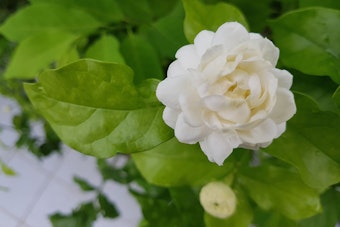
1. Arabian Jasmine
Arabian Jasmine (Jasminum Sambac) is a fragrant evergreen vine with small, white flowers.
- Care: Plant in well-drained soil, provide full sun to partial shade. Prune after flowering and fertilize occasionally.
- Watering: Water regularly, allowing soil to slightly dry between. Mulching helps retain moisture.
- Uses: Ideal for hedges, containers, trellises, and as a fragrant addition to gardens.
- Other: Attracts bees and butterflies with its fragrant flowers.
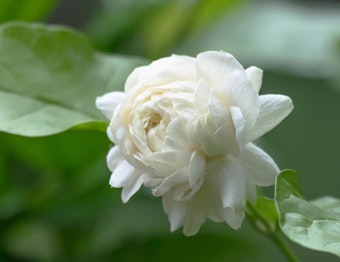
2. Summer Soul® Arabian Jasmine
Summer Soul® Arabian Jasmine (Jasminum sambac 'Summer Soul' is a fragrant vine with large, sweet-scented white flowers and glossy foliage.
- Care: Plant in well-drained soil, provide sun to partial shade, protect from frost. Light pruning and balanced fertilizer.
- Watering: Water regularly, allowing soil to slightly dry between. Grows best with deep watering and mulching.
- Uses: Ideal for hedges, containers, trellises, and fragrance gardens.
- Other: Resistant to pests/diseases. Attracts pollinators, particularly bees and butterflies, with its fragrant flowers.
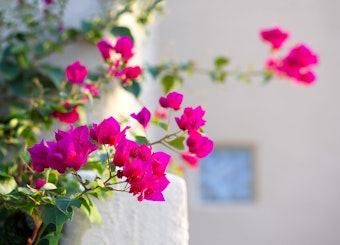
3. Bougainvillea
Bougainvillea (Bougainvillea spp.) is a thorny vine known for its vibrant, showy bracts in various colors.
- Care: It thrives in full sun and well-draining soil. It is highly drought-tolerant and prefers dry conditions.
- Watering: Water deeply and infrequently once established. Allow the soil to dry out between waterings.
- Uses: This beautiful and versatile vine can be used as a climbing vine, ground cover, or in hanging baskets.
- Other: Attracts bees, butterflies, and hummingbirds.
For more about bougainvillea vines, click here.
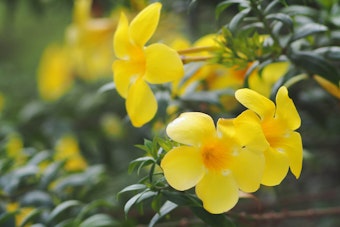
4. Carolina Jasmine
Carolina Jasmine (Gelsemium sempervirens) is an evergreen vine with fragrant yellow trumpet-shaped flowers.
- Care: It prefers full sun to partial shade and well-drained soil.
- Watering: Water regularly, especially during the growing season. Keep the soil evenly moist but not waterlogged.
- Uses: This fragrant vine that can be grown along fences, trellises, or arbors. It adds a sweet fragrance and yellow flowers to the desert garden.
- Other: Attracts bees and butterflies.
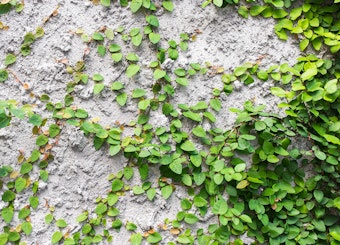
5. Creeping Fig
Creeping Fig (Ficus pumila), also known as climbing fig vine, is an evergreen vine with inconspicuous flowers, and small, heart-shaped leaves that attach to surfaces.
- Care: It prefers partial shade to full shade and well-drained soil. It can tolerate a range of temperatures but benefits from protection in extreme heat.
- Watering: Water regularly, keeping the soil evenly moist. Avoid overwatering.
- Uses: This low-growing vine works well as a ground cover or can be trained to climb walls, fences, or topiaries. Its small leaves create a dense and attractive cover.
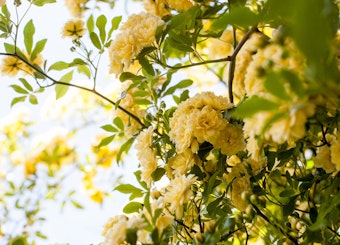
6. Lady Bank's Rose
Lady Bank's Rose (Rosa banksiae) is a thornless, evergreen vine with clusters of small, fragrant yellow or white flowers.
- Care: It prefers full sun and well-drained soil.
- Watering: Water deeply and infrequently once established. Allow the soil to dry out between waterings.
- Uses: This thornless climbing rose can be trained on trellises, walls, or arbors to add elegance to the garden.
- Other: Attracts bees and butterflies.
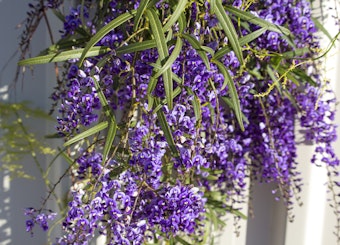
7. Lilac Vine
Lilac Vine (Hardenbergia violacea) is an evergreen vine with slender, twining stems and clusters of purple, pink, or white pea-like flowers.
- Care: It thrives in full sun to partial shade and well-drained soil.
- Watering: Water regularly during the growing season, allowing the soil to dry out slightly between waterings.
- Uses: Versatile plant suitable for ground cover, climbing along trellises, containers, erosion control, attracting pollinators, and providing cut flowers.
- Other: Attracts bees and butterflies.
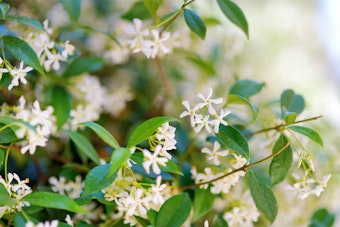
8. Star Jasmine
Star Jasmine (Trachelospermum/Rhynchospermum jasminoides) is an evergreen vine with glossy, dark green leaves and clusters of highly fragrant white flowers.
- Care: It prefers partial shade to full sun and well-drained soil.
- Watering: Water regularly, especially during the hot summer months. Keep the soil consistently moist but not waterlogged.
- Uses: This fragrant vine can be grown on trellises, walls, or used as a ground cover.
- Other: Attracts bees and butterflies.
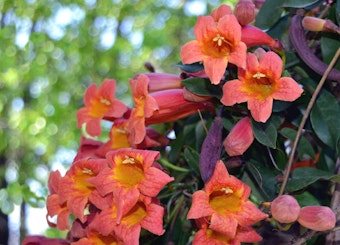
9. "Tangerine Beauty" Crossvine
Crossvine "Tangerine Beauty" (Bignonia capreolata) is a semi-evergreen vine with trumpet-shaped flowers in shades of orange and yellow.
- Care: It prefers full sun to partial shade and well-drained soil. It is heat-tolerant and can handle a range of conditions.
- Watering: Water regularly during the growing season. It is moderately drought-tolerant once established.
- Uses: Can be grown on trellises, fences, or pergolas, providing a burst of color in the desert garden.
- Other: Attracts hummingbirds, bees, and butterflies.
Vine Planting & Growing Tips
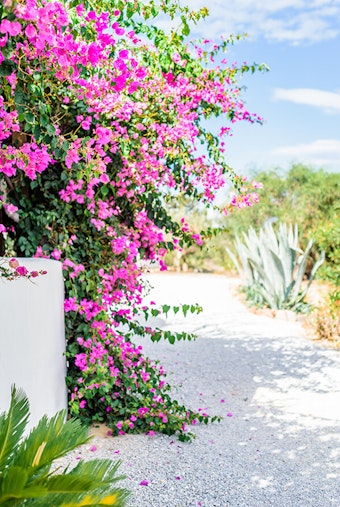
Here are some straightforward planting and growing tips to help get your vines "growing in the right direction":
- Choose the Right Spot: Most vines love the sun but check each vine's needs as indicated above. Some might prefer a little shade during the hottest part of the day.
- Planting Time: The best time to plant is during cooler months, like late fall or early spring. This gives the vines time to settle in and establish a strong root system before the heat of summer.
- Watering Wisely: The above vines will grow best with continued regular watering once established (unless otherwise indicated above). We recommend using a drip irrigation system or watering deeply but infrequently to encourage deep roots (once their root systems have been established).
- Soil Prep: Desert soil can be tough and not very rich in nutrients. Mix in some compost or gardening soil when you plant to give your vines a good start. This helps with drainage and nutrients.
- Support Structures: Some vines climb, and others spread across the ground. For climbers, make sure you have a trellis, fence, or another support in place when you plant. This gives them something to grow on right from the start.
- Mulching: Spread a layer of mulch around the base of your vines. This helps keep the soil moist, keeps weeds down, and protects the roots from extreme temperatures.
- Pruning: Most vines will benefit from occasional pruning to keep them healthy and looking good. It helps control their size, removes dead or diseased parts, and encourages more flowers or foliage.
- Pest and Disease Check: Keep an eye on your vines for any signs of pests or disease. Catching problems early can make a big difference. Use natural or recommended treatments to deal with any issues.
- Patience: Remember, it might take a season or two for your vines to fully establish and start showing off. Give them time and take care of them, and they'll grow into beautiful additions to your garden.
These easy-to-follow tips are designed to help any level of gardener successfully grow beautiful vines in the Valley of the Sun.
Questions? We're here to help along the way!

